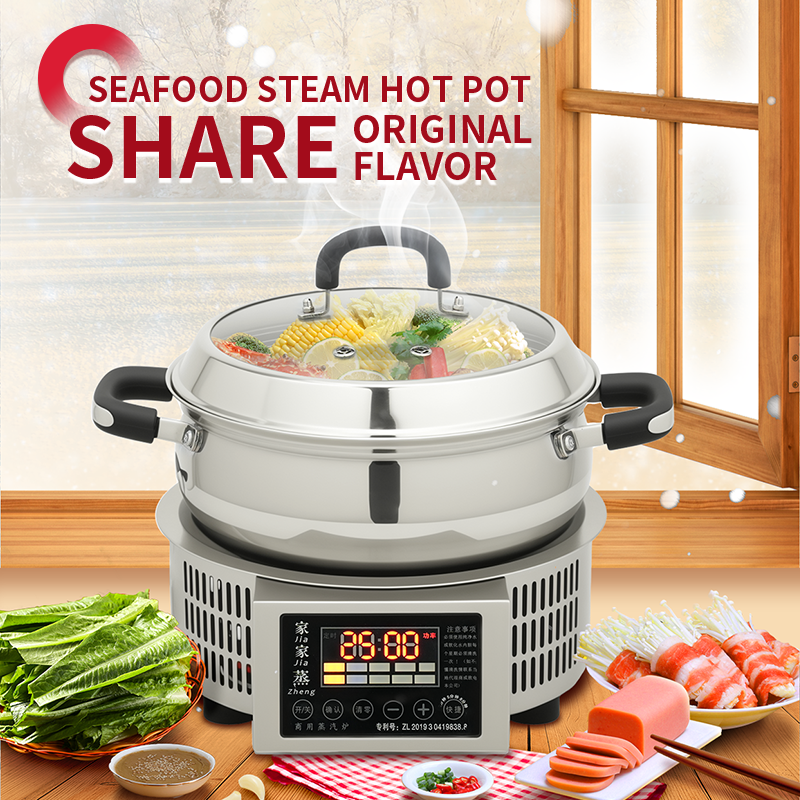Electric Steam Boilers: A Smart Choice for Improving Efficiency and Saving Energy in Commercial Kitchens in Southeast Asia
In modern commercial and industrial applications, electric steam boilers are becoming an increasingly popular choice due to their high efficiency, environmental friendliness, and cost-effectiveness. In particular, in Southeast Asia's booming food and beverage industry, they are becoming a key device to address the pain points of traditional boilers. This article will explore the core advantages and development trends of electric steam boilers and answer some common questions.
Why are electric steam boilers so popular in Southeast Asia?
For commercial kitchens in Southeast Asia (especially central kitchens and chain restaurants), energy-efficient electric steam boilers offer significant advantages:
Excellent Efficiency and Lower Energy Consumption: Electric steam boilers offer extremely high efficiency in heat conversion, effectively reducing energy consumption. Compared to the typical thermal efficiency of 70%-80% for traditional boilers, electric steam boilers offer superior performance and minimize energy losses.
Green and Environmentally Friendly: The boilers operate with zero on-site emissions, significantly reducing the kitchen's direct carbon footprint. This perfectly aligns with increasingly stringent environmental regulations across Southeast Asia (for example, Singapore's carbon tax will increase to S$25 per ton in 2024) and consumer preferences for "green dining." In policy-sensitive markets (such as Singapore and Bangkok, Thailand, which mandate the electrification of night markets), this approach not only avoids fines but also helps secure green subsidies.
Significant long-term economic benefits: While initial investment costs may be slightly higher, its efficiency and low energy consumption can reduce costs in the long term. Competitive electricity prices in some regions further enhance its economic viability.
Equipment Utilization:
Electric boilers maintain almost no efficiency at partial load, while gas boilers experience a significant drop in efficiency (as low as 60%).
If kitchen steam demand fluctuates significantly, electric boilers can achieve an additional 5%-10% annual savings.
Electric boilers are simpler to operate, reducing the need for 0.5 full-time personnel and saving $10,000-$20,000 annually.
The total initial investment for an electric boiler may be 10%-30% higher than a gas boiler (primarily due to increased power capacity), but in some scenarios (such as those without gas pipelines or with low power consumption), it may be comparable or even lower.
Easy Maintenance: Compared to gas boilers, electric steam boilers have a simpler structure, require less maintenance, and are easier to operate. This reduces equipment downtime and labor costs (maintenance labor costs are 40%-60% lower), reduces training time by 60%-80%, and improves overall kitchen operational efficiency.
Flexible Installation: Their compact size and lightweight design, along with 30%-50% fewer parts and 15%-30% smaller footprint, make electric steam boilers adaptable to various space constraints, making them easy to deploy in compact kitchens or mobile food trucks. Safe, reliable, and worry-free: They are often equipped with comprehensive safety features (such as dry-boil protection and overpressure protection) to prevent risks like gas leaks, making them particularly suitable for crowded kitchens.
Adaptable to regional characteristics: Despite high electricity prices in parts of Southeast Asia, the high efficiency and energy-saving characteristics of electric boilers can still achieve lower unit steam costs over the long term. Furthermore, the improved stability of the regional power grid reduces the risks associated with fluctuating fuel supplies.
Benefiting policy dividends: Many Southeast Asian governments actively promote energy-saving equipment, providing subsidies or tax breaks for businesses adopting electric steam boilers, effectively lowering the initial investment threshold and accelerating return on investment. Key mechanism: Subsidies are linked to energy efficiency (requiring a thermal efficiency of ≥95%), which electric boilers naturally meet. A policy breakthrough: Electric steam boiler companies are allowed to qualify for off-peak electricity prices for 90% of their electricity usage (compared to only 30% for conventional companies).
The actual steam cost has been reduced to $7.80 per ton (47% lower than gas boilers).
Empowering central kitchens: Automation and efficiency improvements
As core equipment in modern central kitchens, the combination of electric steam boilers and fully automated steaming lines has brought a qualitative leap forward for Southeast Asian catering businesses:
Stable supply, consistent quality: Electric steam boilers provide continuous and stable steam output, meeting large-scale, long-term cooking needs and ensuring product consistency.
Increased production capacity, precise control: Combined with automated steaming lines, they achieve rapid heating and significantly increase food processing speed. The system can adjust steam volume in real time for precise control, reducing customer wait times. The conveyor speed is adjustable (0.5-2 m/min), and the steamer has three temperature zones (preheating 100°C → main steaming 103°C → setting 98°C).
Shrimp dumplings pass through in just 3 minutes and 50 seconds (65% faster than traditional steaming), while processing capacity is tripled. Energy Saving and Cost Reduction, Green Production: Compared to traditional boilers, electric steam boilers offer higher energy efficiency, resulting in lower energy consumption and carbon emissions, reducing operating costs while also meeting environmental standards.
Clean and Efficient, Ensuring Hygiene: When combined with automated cleaning lines, the steam generated by electric steam boilers can be used to clean equipment, making processes more efficient, reducing the burden and costs of manual cleaning, and ensuring food safety.
Flexible Adaptability, Worry-Free Scalability: Facing fluctuating restaurant demand, the combination of electric steam boilers and automated equipment allows for flexible adjustments to production schedules, easily responding to new menu items or unexpected orders.
Return on Investment Calculation:
The payback period for electric steam boilers in the restaurant industry is only 14-18 months (compared to 3-5 years for traditional boilers).
Based on data from the Ministry of Economy, Trade and Industry of Japan, the faster menu updates enabled by flexible production can increase average customer spending by 12-15%.
World Restaurant Association Case Study: A restaurant chain using an intelligent steam system reduced new product launch time from 45 days to 11 days, and attributed 23% of its annual revenue growth to capacity flexibility. Healthy Diet: Food cooked in an electric steam cooker effectively preserves nutrients and reduces nutrient loss.
A dietary modification project in a Japanese nursing home showed that:
Serum folate levels increased by 19.4% (p<0.01) in the electric steam cooking group compared to the traditional cooking group (3-month follow-up data).
Differentiation in hemoglobin concentration (xi) by +8.2 g/L.
Intelligent Management, Data-Driven: Modern electric steam boilers are often equipped with intelligent control systems that monitor steam production, usage, and energy consumption in real time, helping managers optimize decision-making and improving production transparency and efficiency. Empirical data (Bosch Food Factory in Germany) shows:
Electric steam demand forecasting accuracy: 93.6% (LSTM algorithm vs. 78.2% manual experience)
Peak-off power optimization: Energy storage utilization reached 91% during off-peak hours, reducing overall energy costs by 22.7%
Fault prediction: Bearing overheating warnings were provided 72 hours in advance, reducing repair costs by 65%
Simplified training and rapid onboarding: The user interface of fully electric automatic steam systems is generally user-friendly and intuitive, reducing the difficulty and cost of employee training and enabling new employees to get started more quickly.
The World Bank case study database shows that steam boiler projects using advanced HMIs have an average payback period of 22% (with a 31% contribution to operational efficiency improvements).
Solving the pain points of street vendors: Small space, big energy
Southeast Asia's street food culture is thriving, but vendors often face challenges: traditional boilers are bulky and take up space; gas costs are high and pose a significant fire hazard; and unstable power supply can cause equipment to malfunction.

Real Case Study: Upgrading a Nasi Lemak Food Truck in Kuala Lumpur
Pain Point: The original gas boiler took up 0.8 square meters, costing an average of RM1,200 per month in fuel costs, and was also fined by the municipality for fire hazards.
Solution:
Swapping to a 30-liter electric steam boiler (significantly smaller in size) freed up space for food storage.
Adding solar panels (generating approximately 2 kWh per day) further reduced electricity costs.
Results: The investment payback was within six months, and food production efficiency increased by approximately 20%.
Promotion Model: Government-Enterprise-Vendor Collaboration
Case Study: Ho Chi Minh City's "Green Stall Program"
Government Level:
Renovating the night market's electrical circuits to establish a "dedicated power supply area for electric steam cooker vendors" (stable 220V/no capacity upgrade fee).
Subsidizing 40% of the equipment price (locally certified brands only).
Enterprise Level:
SteamEase offers a "lease-to-own" program:
Deposit $50, monthly payments $10 (including maintenance).
After a three-year lease, the steam equipment returns to the vendor.
Vendor Benefits:
Number of Participating Vendors: 1,200 (23% of downtown vendors)
Overall Cost Reduction: Energy -52%, Accidents -91%
Average Daily Revenue Increase: $8.3 (due to improved efficiency and significantly increased customer trust)
Frequently Asked Questions about Electric Steam Cookers
Q: What should I do if condensation easily forms on the steam cooker casing during the rainy season?
A: We recommend choosing a model with a double-layer insulation design (preferably a gap of ≥5mm between the inner and outer layers). If you already have equipment, wipe off any moisture on the surface immediately after shutting down each day.
Q: What can be done if water pipe joints become loose due to frequent equipment movement?
A: You can use a dedicated threadlocking sealant (such as Loctite 577) to tighten the threaded connections on the water pipes, and make it a habit to check the tightness of the joints monthly.
Risk List:
Overpressure explosion of pressure vessels (ASME standards require triple interlock protection)
Insufficient IP rating of electrical cabinets causing short circuits (must be at least IP54)
Cyberattacks leading to parameter tampering (a company was once subjected to ransomware demanding 5 BTC)
Security Enhancements:
Modbus/TCP + SSL encrypted transmission
Physical emergency stop button response time < 0.3 seconds


